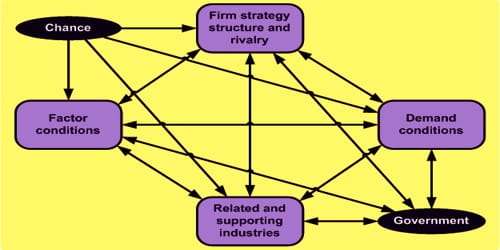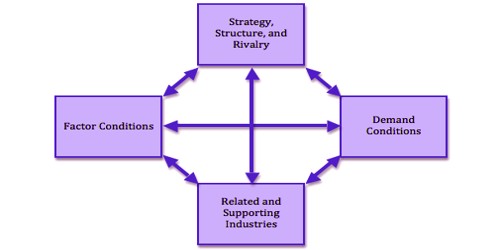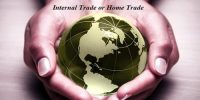Porter’s National Competitive Advantage Theory
In the continuing evolution of international, trade theories, Michael Porter of Harvard Business School developed a new model to explain national competitive advantage in 1990. Michael Porter suggested that the accomplishment of any industry in global trade depends on upgradable and innovational capacities of the business as well as four other factors, which establish how that firm is going to execute in this global level race. Porter’s theory stated that a nation’s competitiveness in an industry depends on the capacity of the industry to innovate and upgrade.
The major perception behind this theory gives believe of holding feature proportion as well as many other international trade theories in it. His theory focused on explaining why some nations are more competitive in certain industries. A nation’s competitiveness depends on the aptitude of its business to innovate and improve. Companies achieve advantage against the world’s best competitors because of demands and dispute. The advantage of having strapping domestic rivals, forceful home-based suppliers, and demanding local customers.
To explain his theory, Porter identified four determinants that he linked together. It describes the factors that contribute to the achievement of organizations in international industries. These factors are called the determinants of the national advantage. The four determinants are –
(1) local market resources and capabilities,
(2) local market demand conditions,
(3) local suppliers and complementary industries, and
(4) local firm characteristics.

- Local market resources and capabilities (factor conditions).
Porter recognized the value of the factor proportions theory, which considers a nation’s resources (e.g., natural resources and available labor) as key factors in determining what products a country will import or export. Porter added to these basic factors a new list of advanced factors, which he defined as skilled labor, investments in education, technology, and infrastructure. He perceived these advanced factors as providing a country with a sustainable competitive advantage. For example, South Korea lacks natural resources, but have expert engineers. Thus, it can be said that the countries that lack natural resources develop new methods or processes that lead to national comparative advantage.
- Local market demand conditions.
Porter believed that a sophisticated home market is critical to ensuring ongoing innovation, thereby creating a sustainable competitive advantage. Companies whose domestic markets are sophisticated, trendsetting, and demanding forces continuous innovation and the development of new products and technologies. Many sources credit the demanding US consumer with forcing US software companies to continuously innovate, thus creating a sustainable competitive advantage in software products and services. The strong demand conditions in the home country persuade the domestic organizations to constantly improve the product. If the demand for a product is more in the domestic market then it can influence the demand of customers in the foreign market.
- Local suppliers and complementary industries.
To remain competitive, large global firms benefit from having strong, efficient supporting and related industries to provide the inputs required by the industry. Certain industries cluster geographically, which provides efficiencies and productivity. In addition, the growth of one industry influences the growth of other industries. For instance, the growth and development of the automobile industry would enhance the growth opportunities of the steel industry.
- Local firm characteristics.
Local firm characteristics include firm strategy, industry structure, and industry rivalry. Local strategy affects a firm’s competitiveness. A healthy level of rivalry between local firms will spur innovation and competitiveness. The strategies help in setting new goals, the structure helps in managing operations, and rivalry helps in generating innovative ideas in organizations.
These four determinants can also be called as the dimensions of the diamond model that help in contributing to the national advantage. According to Porter, these dimensions cooperate with each other and help in increasing the competitiveness of the organizations.
















